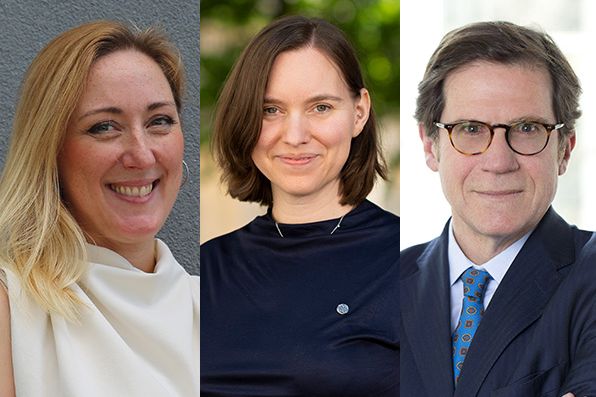FWF "1000 Ideas" programme: Funding grants for three MedUni Vienna researchers

(Vienna,03 August 03 2020) With its new "1000 Ideas" programme, the Austrian Science Fund (FWF) is funding research projects that take innovative scientific approaches. Adelheid Wöhrer from MedUni Vienna's Division of Neuropathology and Neurochemistry, neuroscientist Vanja Nagy from the LBI-RUD, domiciled at MedUni Vienna, and molecular biologist Giulio Superti-Furga, from MedUni Vienna's Institute of Pharmacology and Director of CeMM (Research Center for Molecular Medicine of the Austrian Academy of Sciences), are among the 24 prize-winners in the first call.
"Austria is specifically encouraging its researchers to be innovative. As pioneers in their respective fields, they are able to identify completely new possibilities and lay the foundation for future applications. This not only benefits Austria as a research location but, ultimately, each one of us," explained Science Minister Heinz Faßmann in an FWF press release.
"We are delighted to be able to get the first "1000 Ideas" projects rolling. The first tranche shows the diversity of high-risk research; the projects come from the three major fields of science," said FWF President Klement Tockner, adding: "The aim is to enable researchers at Austrian research institutions to put their visionary ideas into practice. This increases the chances of scientific breakthroughs that benefit everyone – even though the original concept might fail."
In the first call, 24 projects were approved at twelve universities and research institutions, receiving total funding of €3.4 million.
Adelheid Wöhrer: "Clonal Complexity of Glioblastoma"
Tumour heterogeneity is responsible for a poor treatment response, early recurrence of the tumour and limited survival time in many patients. However, it is not standardly recorded in clinical practice and usually only plays a subordinate role in therapeutic decisions.
Glioblastoma is a prototypical example of a genetically heterogeneous tumour. In this project, Adelheid Wöhrer and her colleagues are hypothesising that the number and composition of tumour cell clones vary. The premise is therefore: the more complex the tumour, the more resistant it is to treatment. They are entering largely uncharted waters in that they are considering the tumour not as a static but as a dynamic entity, somewhat like an anthill, which consists of many individual intercommunicating units of differing flexibility. Their methodical approach combines depth sequencing with ambitious spatial and chronological modelling and an ex vivo model that allows drug screening with fully preserved tumour heterogeneity. The transformative potential of this project lies not only in developing tumour heterogeneity one step further towards a clinical biomarker but ultimately in directly influencing it through a better mechanistic understanding.
About Adelheid Wöhrer
Adelheid Wöhrer studied medicine at the Medical University of Vienna, where she wrote her thesis on brain tumour epidemiology as part of the Clinical Neurosciences doctoral programme. Since then she has been working as a neuropathologist at the Division of Neuropathology and Neurochemistry within the Department of Neurology. She has spent research placements at Samsung Medical Center in South Korea, where she refined her skills in digital pathology.
Within the framework of the "1000 Ideas" project, she will be working closely with Georg Widhalm from the Department of Neurosurgery, Christoph Bock from the CeMM and Bernhard Baumann from the Center for Medical Physics and Biomedical Engineering.
Vanja Nagy: "Reverse Engineering of Neurodevelopmental Disorders"
Due to the potential offered by gene sequencing, we already know of 1000 genes that can cause neurodevelopmental disorders. However, in around 40% of cases, the causes of disorders have not yet been investigated. For the purposes of the study, the researchers developed the computer-based "ID Interaktom", which represents a network of all genetic interactions. The normal work-flow is reversed using CRISPR-Cas9 gene editing. Once this is done, pathogenic genes are functionally validated and then compared with the genetic profile of patients. The study also offers insights into fundamental cellular neurobiology.
About Vanja Nagy
Vanja Nagy studied at the Icahn School of Medicine at Mount Sinai, USA. She runs her own research group at the Ludwig Boltzmann Institute for Rare and Undiagnosed Diseases (LBI-RUD) in Vienna, which is domiciled at MedUni Vienna's Division of Neurology. In addition to this, she is Adjunct Principal Investigator at the CeMM. For the "1000 Ideas" project, she will be working with Jörg Menche from the CeMM.
Giulio Superti-Furga: "The Human Mini Cell"
Is it possible to generate a human "mini cell", with a 5 – 30% reduced genome, which can survive in culture? The aim of this "1000 Ideas" project is to provide science with a simplified system for studying cellular processes and metabolism.
About Giulio Superti-Furga
Giulio Superti-Furga studied molecular biology at the University of Zürich. He has been Scientific Director of the CeMM since 2005 and Professor of Molecular Systems Biology at the Medical University of Vienna since 2015. He is also a member of the Austrian Academy of Sciences, the German National Academy of Sciences Leopoldina, the European Molecular Biology Organization (EMBO), the European Academy of Cancer Sciences, Academia Europaea. He was also Chair of the EMBL Alumni Association until the end of 2015.